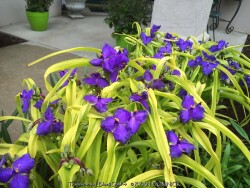

***Description for this perennial available with future update!***Blue & Gold Spiderwort, is also known as Tradescantia x andersoniana 'Blue and Gold'


***Description for this perennial available with future update!***Concord Grape Spiderwort, is also known as Tradescantia x andersoniana 'Concord Grape'
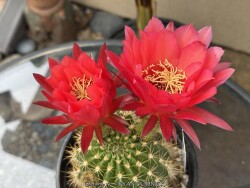

***Description for this plant available with future update!*** Trichocereus grandiflorus is also known as Torch Cactus (Tropical)>>>>> Cacti are known for their spines, unusual shapes and beautiful flowers. Both succulents and cacti store water in their fleshy tissues. And can survive long periods without water. Cacti and succulents are usually grown as a deck/patio plant or house plant in Kansas. Grow in full sun with little to no extra watering except that which comes from rainfall. Generally, plants may be brought out in Late May through Early October in our zone 6a Lawrence, KS climate. To play is safe, potted plants are best moved in before autumn leaves begin to drop and before night temperatures get below 45 degrees F. It is very important to avoid the combination of wet and cold. Move to a bright interior window over the winter with little to no watering and keep above 50 degrees F. As a winter house plant, it will look presentable all winter long with little to no waterings. As a permanent house plant, provide bright light and allow the soil to dry completely between waterings and you will get many years of carefree enjoyment. Plants grown permanently indoors may eventually begin to elongate stretching for light and lose their spine color. It can be hard to reproduce the intense UV sunlight they need when growing indoors so moving outside for the summer is best. Generally if moving outside for the summer, allow 1-2 weeks of part shade or morning sun before placing in full sun. Plants with time to acclimate will thrive in full sun but be careful not to rush it or sunburning may occur. Repotting may or may not be needed depending on how large you want the plant to grow; plants can continue to grow taller and tolerate extremely root-bound pots but may need wind bracing. If repotting, make sure to use a sharp draining low organic cactus mix with plenty of sand and perlite but avoid peat moss. The “soil” most commercial cacti are potted in to too peaty and light weight. This soil becomes hydrophobic and shrinks after becoming bone dry and difficult to re wet again. Cacti never grow in peat-based soils in nature; this “Soil” is only good for shipping because of the light weight. Potted plants are very low maintenance but watch for scale and mealybugs that may hide beneath the cover of spines. The best pest removal approach is to periodically wash the cactus off. Achieve this with a water nozzle or hose breaker turned mostly off to increase the pressure from the blast of water. This high-pressured water kills the pests without damaging the thick cactus skin. Here are some little-known or rare factoids about cacti: 1. The "spines" are actually modified leaves filled with sap at first, then quickly drying out to form the spines! 2. Many cacti have bright colored flowers that mainly attract bees, while some tubular flowering types attract hummingbirds and bats. 3. Late on the evolutionary timeline, cacti fossils are rare to non-existent. Cacti are native almost exclusively to the Americas, while succulents can include a much larger plant palette be from any dry area in the world. 4. Some cactus plants have been known to survive more than 2 years without water. 5. Some cacti first evolved in a dry climate that later became wetter again. For example: several jungle species live as epiphytes in trees to achieve the fast drainage they need.
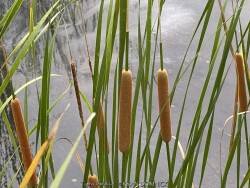

***Description for this water plant available with future update!*** Typha latifolia is also known as Broadleaf Cattail >>>>>>>>>>This plant is usually grown as a bog plant needing constantly moist soil rich in organic matter. As a rain garden plant, it will thrive is a depressed area in the landscape that collects rain water from a roof during spring and summer periods of rain but then go dormant if the water hole dries out completely. For the home garden, the species is generally too aggressive to mix with other plants
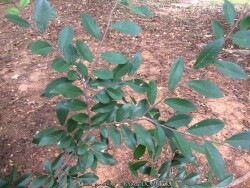

***Tree descriptions available with future update!***Lacebark Elm, is also known as Ulmus parvifolia


Sky Dew Gold ornamental blueberry has such appealing bright gold foliage that the flowers and berries are almost an afterthought. Its display gets even more interesting as the summer nights start to cool, and the golden foliage starts taking on rich hues of orange and red. The effect is simply thrilling; seeing something so colorful and cheerful puts a smile on your face. Highbush Blueberry, (Vaccinium corymbosum) needs rich organic acidic soil. You can easily create this by adding a mound of ground up leaves from your fall cleanup each year.
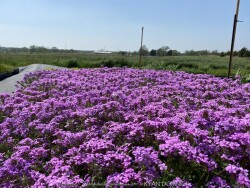

***Description for this perennial available with future update!***Native Rose Verbena / Glandularia (flat), is also known as Verbena / Glandularia canadensis
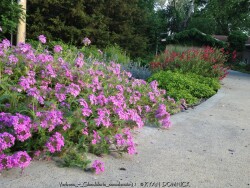

***Description for this perennial available with future update!***Native Rose Verbena / Glandularia, is also known as Verbena / Glandularia canadensis
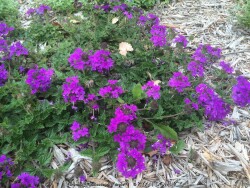

***Description for this plant available with future update!*** Verbena canadensis 'Homestead Purple' is also known as Homestead Purple Verbena.
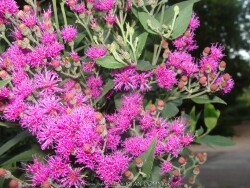

***Description for this perennial available with future update!*** Vernonia baldwinii is also known as Western Ironweed.


***Description for this perennial available with future update!*** Vernonia baldwinii is also known as Western Ironweed.
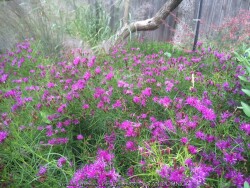

Narrow-leaf Ironweed (Vernonia lettermannii) is a relatively new plant to horticulture; originally discovered in Arkansas along gravel stream beds in the wild. The Iron Butterfly cultivar (Vernonia lettermannii 'Iron Butterfly') is a dwarf compact cultivar introduced by Dr. Allan Armitage at the University of Georgia. This is a true four-seasons perennial that belongs in almost every perennial garden. In the spring, narrow dark green foliage resembling Amsonia hubrichtii creates a compact shrub-like appearance. The growth is so dense that no weeds have a chance of invading a mature stand of plants. By mid to late summer, gorgeous deep purple fine-textured flowers cover the plant for 4-6 weeks. Butterflies, bees, and other pollinators flock to the occasion. Following the bloom, the flower stocks are sturdy and hold up very well for fall and winter interest. The flowers themselves produce mostly non-viable seed and cling to the plant creating a silvery shine whenever sunlight hits it. This can be very useful and dried flower arrangements as well as winter interest gardens. At some point in the winter, all top growth will need to be cut back as this is the only maintenance required. Despite being native to gravel and sand bars along rivers, Iron butterfly Vernonia surprisingly can handle very dry clay, gravelly, or sandy soils along with short periods of flooding. Permanently wet soil is not favored but it can handle the upper portions of a rain garden. Iron butterfly has only one pest problem and that is rabbits! If rabbits are an issue, just put a bowl-shaped chicken wire cage around the plants for the first year. By year #2, the rapidly growing foliage will outgrow any detrimental rabbit browsing. This is definitely one of the most adapted landscape plants in Kansas zone 6a with no problems with heat or cold, dry or wet! It's hard to imagine a perennial garden without this plant!
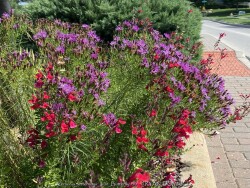

Narrow-leaf Ironweed (Vernonia lettermannii) is a relatively new plant to horticulture; originally discovered in Arkansas along gravel stream beds in the wild. The Iron Butterfly cultivar (Vernonia lettermannii 'Iron Butterfly') is a dwarf compact cultivar introduced by Dr. Allan Armitage at the University of Georgia. This is a true four-seasons perennial that belongs in almost every perennial garden. In the spring, narrow dark green foliage resembling Amsonia hubrichtii creates a compact shrub-like appearance. The growth is so dense that no weeds have a chance of invading a mature stand of plants. By mid to late summer, gorgeous deep purple fine-textured flowers cover the plant for 4-6 weeks. Butterflies, bees, and other pollinators flock to the occasion. Following the bloom, the flower stocks are sturdy and hold up very well for fall and winter interest. The flowers themselves produce mostly non-viable seed and cling to the plant creating a silvery shine whenever sunlight hits it. This can be very useful and dried flower arrangements as well as winter interest gardens. At some point in the winter, all top growth will need to be cut back as this is the only maintenance required. Despite being native to gravel and sand bars along rivers, Iron butterfly Vernonia surprisingly can handle very dry clay, gravelly, or sandy soils along with short periods of flooding. Permanently wet soil is not favored but it can handle the upper portions of a rain garden. Iron butterfly has only one pest problem and that is rabbits! If rabbits are an issue, just put a bowl-shaped chicken wire cage around the plants for the first year. By year #2, the rapidly growing foliage will outgrow any detrimental rabbit browsing. This is definitely one of the most adapted landscape plants in Kansas zone 6a with no problems with heat or cold, dry or wet! It's hard to imagine a perennial garden without this plant!


***Description for this perennial available with future update!*** Vernonia lettermannii 'Summers Swan Song' is also known as Summers Swan Song Narrow-leaf Ironweed >>>>> Narrow-leaf Ironweed (Vernonia lettermannii) is a relatively new plant to horticulture; originally discovered in Arkansas along gravel stream beds in the wild. The Iron Butterfly cultivar (Vernonia lettermannii 'Iron Butterfly') is a dwarf compact cultivar introduced by Dr. Allan Armitage at the University of Georgia. This is a true four-seasons perennial that belongs in almost every perennial garden. In the spring, narrow dark green foliage resembling Amsonia hubrichtii creates a compact shrub-like appearance. The growth is so dense that no weeds have a chance of invading a mature stand of plants. By mid to late summer, gorgeous deep purple fine-textured flowers cover the plant for 4-6 weeks. Butterflies, bees, and other pollinators flock to the occasion. Following the bloom, the flower stocks are sturdy and hold up very well for fall and winter interest. The flowers themselves produce mostly non-viable seed and cling to the plant creating a silvery shine whenever sunlight hits it. This can be very useful and dried flower arrangements as well as winter interest gardens. At some point in the winter, all top growth will need to be cut back as this is the only maintenance required. Despite being native to gravel and sand bars along rivers, Iron butterfly Vernonia surprisingly can handle very dry clay, gravelly, or sandy soils along with short periods of flooding. Permanently wet soil is not favored but it can handle the upper portions of a rain garden. Iron butterfly has only one pest problem and that is rabbits! If rabbits are an issue, just put a bowl-shaped chicken wire cage around the plants for the first year. By year #2, the rapidly growing foliage will outgrow any detrimental rabbit browsing. This is definitely one of the most adapted landscape plants in Kansas zone 6a with no problems with heat or cold, dry or wet! It's hard to imagine a perennial garden without this plant!


***Description for this perennial available with future update!*** Vernonia baldwinii is also known as Western Ironweed.
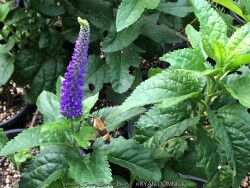

***Description for this perennial available with future update!***Sunny Border Blue Veronica, is also known as Veronica 'Sunny Border Blue'


***Description for this perennial available with future update!*** Veronica spicata 'Purpleicious' is also known as Purpleicious Veronica.
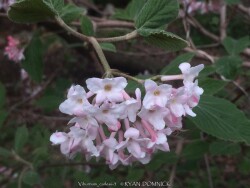

***Shrub descriptions available with future update!*** Viburnum carlesii is also known as Korean Spice Pink Flowering Viburnum.
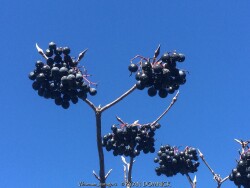

***Tree descriptions available with future update!*** Viburnum lentago is also known as Nannyberry Viburnum / Edible Tree Viburnum


***Shrub descriptions available with future update!*** Viburnum nudum 'Brandywine' is also known as Brandywine Viburnum.
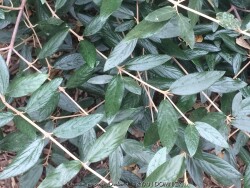

***Shrub descriptions available with future update!*** Viburnum pragense 'Decker' is also known as Decker Prague Evergreen Viburnum >>>>>>>>>>>>Decker Prague Evergreen Viburnum (Viburnum pragense 'Decker') is a hybrid between leatherleaf viburnum and ‚The key difference is that Prague viburnum is slightly faster growing and more consistent reliable evergreen foliage. Foliage is more of a green color during the winter and very glossy. Craig viburnum has more narrow denser foliage. It can be easily pruned into a green wall or large hedge for screening.


***Shrub descriptions available with future update!***Blackhaw Native Viburnum, is also known as Viburnum prunifolium
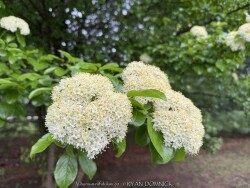

***Shrub descriptions available with future update!***Rusty Blackhaw Native Viburnum, is also known as Viburnum rufidulum
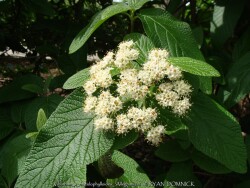

Leatherleaf viburnum is a large semi-evergreen shrub with leathery leaves and cream white flowers. Foliage emerges light green with powdery white material on the backside of the leaf. Foliage darkens to a medium green by summer and finally turning to a purplish winter color. About half of the foliage drops in the winter but is still effective enough for a partial screening. Flowers bloom mostly in spring but sporadically throughout the year. If pollination occurs, red fruits follow in the late summer thru fall creating quite a show. More than one variety is typically required for pollination. Leatherleaf viburnum prefers medium to rich garden soil in full to part sun. Being one of the toughest viburnums around, it can handle much less than ideal conditions including dry shade. Typically our are 40 inches of rainfall per year in eastern Kansas is enough without extra water. However, during times of drought, the foliage will wilt and growth will stop. Luckily the foliage is able to survive in a wilted state for a long time (usually up to two or three weeks) before actually dying. This gives you plenty of notice that it needs water. There is virtually no maintenance except rejuvenation on very old plants. Yearly fertilizer application is appreciated. When given plenty of room to grow, Leatherleaf Viburnum can reach up to 8 or 12 feet tall and wide after 20-30 years. Eventually old canes become unproductive and should be removed allowing young vigorous canes to develop. Leatherleaf viburnum grows slow at first especially in rough soils but the key thing is that it will survive and grow faster when established. Cold hardiness is not a problem in Lawrence Kansas zone 6a but in colder climates expect winterkill down to the ground in some years. Considered one of the best plants for solving your most difficult dry-shade landscape challenges. Several improved cultivars exist. Alleghany Leatherleaf Viburnum (Viburnum x rhytidophylloides 'Alleghany') has improved cold hardiness and growth form.


Leatherleaf viburnum is a large semi-evergreen shrub with leathery leaves and cream white flowers. Foliage emerges light green with powdery white material on the backside of the leaf. Foliage darkens to a medium green by summer and finally turning to a purplish winter color. About half of the foliage drops in the winter but is still effective enough for a partial screening. Flowers bloom mostly in spring but sporadically throughout the year. If pollination occurs, red fruits follow in the late summer thru fall creating quite a show. More than one variety is typically required for pollination. Leatherleaf viburnum prefers medium to rich garden soil in full to part sun. Being one of the toughest viburnums around, it can handle much less than ideal conditions including dry shade. Typically our are 40 inches of rainfall per year in eastern Kansas is enough without extra water. However, during times of drought, the foliage will wilt and growth will stop. Luckily the foliage is able to survive in a wilted state for a long time (usually up to two or three weeks) before actually dying. This gives you plenty of notice that it needs water. There is virtually no maintenance except rejuvenation on very old plants. Yearly fertilizer application is appreciated. When given plenty of room to grow, Leatherleaf Viburnum can reach up to 8 or 12 feet tall and wide after 20-30 years. Eventually old canes become unproductive and should be removed allowing young vigorous canes to develop. Leatherleaf viburnum grows slow at first especially in rough soils but the key thing is that it will survive and grow faster when established. Cold hardiness is not a problem in Lawrence Kansas zone 6a but in colder climates expect winterkill down to the ground in some years. Considered one of the best plants for solving your most difficult dry-shade landscape challenges. Several improved cultivars exist. Darts Duke Leatherleaf Viburnum (Viburnum x rhytidophylloides 'Dart's Duke') features larger dark green foliage, larger flowers, better density, and pink cottony flock on the back of new leaves and new stems instead of white. All Proven Winners® plants are legally propagated, healthy and vigorous, true to name, and tagged with color pictures and growing information.
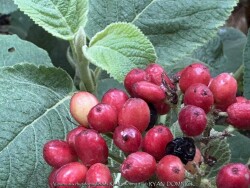

Leatherleaf viburnum is a large semi-evergreen shrub with leathery leaves and cream white flowers. Foliage emerges light green with powdery white material on the backside of the leaf. Foliage darkens to a medium green by summer and finally turning to a purplish winter color. About half of the foliage drops in the winter but is still effective enough for a partial screening. Flowers bloom mostly in spring but sporadically throughout the year. If pollination occurs, red fruits follow in the late summer thru fall creating quite a show. More than one variety is typically required for pollination. Leatherleaf viburnum prefers medium to rich garden soil in full to part sun. Being one of the toughest viburnums around, it can handle much less than ideal conditions including dry shade. Typically our are 40 inches of rainfall per year in eastern Kansas is enough without extra water. However, during times of drought, the foliage will wilt and growth will stop. Luckily the foliage is able to survive in a wilted state for a long time (usually up to two or three weeks) before actually dying. This gives you plenty of notice that it needs water. There is virtually no maintenance except rejuvenation on very old plants. Yearly fertilizer application is appreciated. When given plenty of room to grow, Leatherleaf Viburnum can reach up to 8 or 12 feet tall and wide after 20-30 years. Eventually old canes become unproductive and should be removed allowing young vigorous canes to develop. Leatherleaf viburnum grows slow at first especially in rough soils but the key thing is that it will survive and grow faster when established. Cold hardiness is not a problem in Lawrence Kansas zone 6a but in colder climates expect winterkill down to the ground in some years. Considered one of the best plants for solving your most difficult dry-shade landscape challenges. Several improved cultivars exist. Red Balloon Leatherleaf Viburnum (Viburnum x rhytidophylloides 'Red Balloon') features significant improvements. In spring, large, lacy white flower clusters cover the plant, followed by green fruit which turns brilliant red in late summer. The thick, leathery foliage lends a distinguished, handsome look to the plant all season. This viburnum will develop some berries without another variety as a pollinator, but you'll get more fruit if planted around 'Mohican' or 'Alleghany.' Proven Winners® plants are legally propagated, healthy and vigorous, true to name, and tagged with color pictures and growing information.
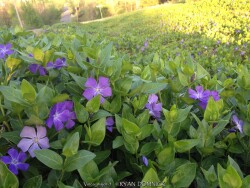

***Description for this perennial available with future update!***Vinca Major / Periwinkle, is also known as Vinca major


***Description for this perennial available with future update!***Variegated Vinca Major, is also known as Vinca major 'Variegata'
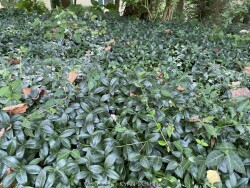

Vinca Minor / Periwinkle is an evergreen groundcover native to central and southern Europe but naturalized and has become invasive in parts of North America. The evergreen leaves are a glossy dark green with a leathery texture. The 5-petal violet-purple flowers are produced mainly from early spring to mid summer but with a few flowers still produced into the autumn. Landscape uses include small scale groundcovers and hillside areas in full to part shade. In full sun, foliage burn occurs in late summer and with slow recovery, weeds find an opportunity to invade. Due to slow spreading growth in our Kansas climate, you shouldn't leave very much room in-between vinca plants or you will be waiting many years for the patch to fill in. Weeds can again be a problem in that open area between plants if spacing is too wide. We recommend 9-12" spacing and use for small nooks in the shade garden. If planning for a larger area, still figure on the tight spacing but allow for a higher budget that you will consider a permanent investment. However, a serious vine stem canker (blight / disease), limits its use in our area and can damage or kill large patches. Good air circulation and limiting night-time irrigation can reduce the prevalence of this disease. Generally this plant declines after a few years of Kansas climate but worth a try in perfect soils in well-tended shade gardens. The canker disease and competition with weeds seem to be an issue. Roundup effectively eraticates patchy leftover remnant growth after disease runs its course when clearing the area for better groundcover species.
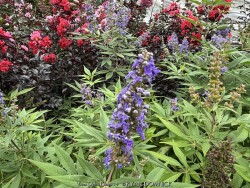

Description from First Editions: Delta Blues™ Chastetree is an intermediate sized shrub that has fragrant, dark blue-purple flowers that attract butterflies and other pollinators. Dark green, fragrant leaves contrast against the colorful flowers that bloom from June to October. Delta Blues™ is deer resistant, salt tolerant, and adapts to acid or alkaline soils as long as the site is well drained. Fun fact: Delta Blues™ was the first intermediate Vitex in the market!
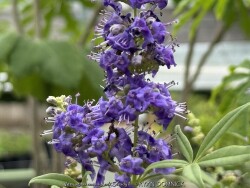

Vitex agnus-castus 'Rock Steady' is a new breakthrouth in the market. In Eastern Kansas, this cultivar performs WELL with just about everything nature has to challenge it! Extreme heat and drought are tolerated. Cold tolerance is no problem in our zone 6. If winter die-back occurs, cut back in March/April and flowers will occur on new growth this year. No disease or pest problems. Great plant for berms, hot West or South exposures, and most any other garden situations in full sun. Will tolerate clay soils and extra moisture in summer. Combine with caryopteris, crapemyrtle, and butterflybush to create a late season "all you can eat" buffet for pollinators!
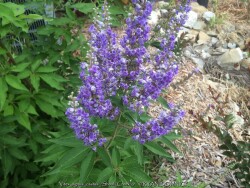

Vitex agnus-castus 'Shoal Creek' is also known as Shoal Creek Vitex / Chastetree. In Eastern Kansas, this cultivar performs WELL with just about everything nature has to challenge it! Extreme heat and drought are tolerated. Cold tolerance is no problem in our zone 6. If winter die-back occurs, cut back in March/April and flowers will occur on new growth this year. No disease or pest problems. Great plant for berms, hot West or South exposures, and most any other garden situations in full sun. Will tolerate clay soils and extra moisture in summer. Combine with caryopteris, crapemyrtle, and butterflybush to create a late season "all you can eat" buffet for pollinators! According to our supplier, this PROVEN WINNERS selection of vitex is incredibly long-blooming - 6-16 weeks longer than six other popular varieties of vitex, according to our trials. Sprays of beautiful lavender flowers grace the plant from late spring through fall, attracting pollinators and fending off heat, drought, and deer like it was born to do it. It is, of course, heat tolerant, but also surprisingly hardy.
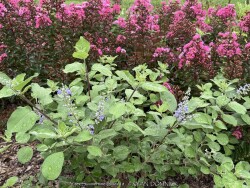

Description from plant breeder, Plant Nouveau: "This new hybrid vitex breaks all of the rules! Selected from a batch of vitex crosses made by former V.P. of Horticulture, Kris Jarantoski of the Chicago Botanic Garden, Summertime Blues has a rounded habit with exceptionally large individual flowers held on black stems. Just imagine a vitex with improved hardiness, that flowers most of the summer and can be used as a shrub…and you have Summertime Blues! Undisputedly an improved selection, Summertime Blues offers multi-season interest for gardens from California to Chicago and even in the deep south. Extreme drought tolerance, a more manageable size, and sterile flowers make the perfect combination for this work horse, easy-to-care-for shrub. Note: This plant has produced no viable seed for the past 15 years and therefore should not have the invasive tendencies of Vitex rotundifolia, which is one of its parents." Vitex agnus castus x rotundifolia ‘Helen Froehlich’ PP31660, Summertime Blues™ is quite a mouthful to say but well worth it in the landscape. We are testing the claims that it may be winter hardy as a shrub with less die back in our Lawrence, KS zone 6a display garden. This is the first year of texting...2024! We will keep you posted.


Silver Dollar Plant (Xerosicyos danguyi) are unique because they have perfectly round leaves and vining stems. These tropical vines have a few requirements in order to thrive but nothing too hard. Give them bright indirect light and water only when dry. They are usually grown as a house plant in Kansas but can be moved outside if kept in full to part shade. Leaves can sunburn but morning or filtered sun is ok! Xerosicyos danguyi is native to West and South-West Madagascar. In the wild, this species subarid bushland forest and dunes that occasionally frost. Potted plants are hardy to at least 25 degrees F for a short time if kept dry so you are ok if you miss the first light frost. Do not allow the pot with rootball to freeze solid though. Move into a cold garage, basement, or bright window over the winter with occasional watering. As a winter house plant, it will look presentable all winter long with just a few waterings. Repotting may or may not be needed depending on how large you want the plant to grow; plants can continue to grow in the same pot for years. If repotting, make sure to use a sharp draining medium organic cactus mix with plenty of sand and perlite. To play is safe, outside potted plants are best moved in before night temperatures get below 35 degrees F. It is important to avoid the combination of wet and cold. Potted plants are very low maintenance; I have never seen a pest on this plant. This is relatively rare plant never seen at the big box stores and will command a higher price than most other houseplants.
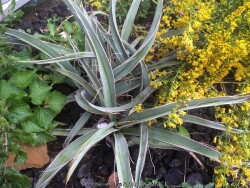

Bluish-green curved leaves from this yucca (Yucca baccata) make an excellent architectural statement. Used as a patio plant in Kansas, place in full sun with no extra watering except from rainfall. Repotting may or may not be needed depending on how large you want the plant to grow. Potted plants are hardy to at least -5 to -15 degrees F if kept dry so you can wait awhile to move these in for the winter. Then move into a cold garage, basement, or bright window over the winter with NO watering. You may also leave this plant outside if under a dry overhang all winter and freeze solid if desired. A suggestion to make this plant a lot more safe around your eyeballs is to clip the new spines off as the new leaves slowly unfurl. It is suggested to buy a large plant to start with as growth is slow. I have never seen this species flower in Kansas, but if it does, the young flower stalks can be cooked and eaten, with the tough outer rind discarded. The fruit can be also be eaten raw or cooked. Yucca baccata occurs in a large area of the North American deserts and exhibits much variation across its range. Yucca baccata specimens we sell are from the higher, mountainous regions of the Rocky Mountains with increased winter hardiness. Having desert heritage, it resents poor drainage and winter moisture. To counteract that in Kansas, plant in full sun on berm or south-facing wall with poor sandy or rocky soil with no irrigation. A large 2-3' wide specimen has flourished in our display garden in Lawrence, KS for over 15 years. It is planted partially under a south facing roof overhang and has survived -16 degrees F and a week of single digit highs in February, 2021. Amazing that a yucca native to areas receiving 4-5" of rain per year can grow in a climate receiving 10 times more rain! ADDITIONAL INFORMATION ABOUT CREVICE GARDENING: In nature, some of the most interesting xeric plants grow in tough places such as inhospitable rock outcroppings with almost no soil. We can recreate that specific and exclusive growing environment with a crevice garden. Crevice gardening allows you to grow cold-hardy cacti and succulents that are normally cold hardy to our climate (Lawrence, KS zone 6a) but not normally tolerant of excessive moisture (40"/year), especially in the winter. This technique provides optimal xeriscape growing conditions by limiting the amount of soil and water around the roots and reducing the potential of root rot. Start with a raised mound of fast draining soil mix consisting mostly of decomposed granite, coarse sand, gravel, and a small amount of organic matter. Incorporate vertical rock formations such as flagstone into a raised landscape bed creating narrow 1-2" wide crevices filled with the soil mix. This helps quickly channel rain and snow melt water down more deeply into the soil encouraging deeper root growth while keeping the soil dry around the base of the plant. It is important that the entire mound is well above grade level to avoid drainage problems; crevice gardens typically range from 12"-36" tall. After installing the plants, mulch with a thin layer of pea-gravel or decomposed granite. In our Lawrence Kansas zone 6a winters with occasional polar vortexes or arctic blasts, this technique works well in any hot microclimate such as a south facing side of a berm or under a south or west facing roof overhand of a house or building. Kansas Plant Farm LLC built a trial crevice garden in 2022 and we have now had enough time to evaluate the plants after a true winter cold spell. During the arctic blast of January 2024, low nighttime temperatures got down to -11 degrees F (Jan 10th,2024). The longevity of this cold blast was also impressive: 4 days on a row with single digit highs including 1 day with a daytime negative high(-2F), 4 nights of lows in negatives (-8For lower), and 48 straight hours of 0 degrees F and mostly lower. A light snow cover helped insulate the ground but wind blew off most powdery snow on the foliage exposing the top parts of the plants to some extreme temperatures with surprisingly little damage. In our crevice trial gardens in Lawrence, KS (zone 6a), this variety survived so far.
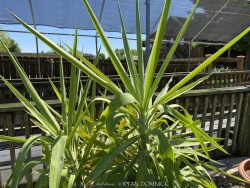

Green sword-like leaves from this yucca (Yucca elephantipes) make an excellent architectural statement. This yucca is native to Mexico and Guatamala but used as a patio plant in Kansas. Place in full sun to part sun with optional extra watering including that which comes from rainfall. Repotting may or may not be needed depending on how large you want the plant to grow; plants can continue to grow taller and tolerate extremely root-bound pots but may need wind bracing. Potted plants are hardy to at least 25 degrees F for a short time if kept dry so you are ok if you miss the first light frost. Do not allow the pot with rootball to freeze solid though. Move into a cold garage, basement, or bright window over the winter with occasional watering. As a winter house plant, it will look presentable all winter long with just a few waterings. Luckily monocarpic flowering will never occur in a potted yucca so you don't have to worry about death after flowering. Potted plants are very low maintenance needing only old leaves trimmed once per year.
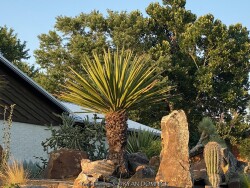

Bright green sword-like leaves from this yucca (Yucca faxoniana) make an excellent architectural statement. Used as a patio plant in Kansas, place in full sun with no extra watering except from rainfall. Repotting may or may not be needed depending on how large you want the plant to grow. Potted plants are hardy to at least 10 degrees F if kept dry so you can wait awhile to move these in for the winter. Then move into a cold garage, basement, or bright window over the winter with NO watering. Many yuccas, including this one, may also be grown from rhizomes, stem cuttings, or by digging offsets from the side of established plants. Having desert heritage, it resents poor drainage and winter moisture. To counteract that in Kansas, plant in full sun on berm with poor sandy or rocky soil with no irrigation. ADDITIONAL INFORMATION ABOUT CREVICE GARDENING: In nature, some of the most interesting xeric plants grow in tough places such as inhospitable rock outcroppings with almost no soil. We can recreate that specific and exclusive growing environment with a crevice garden. Crevice gardening allows you to grow cold-hardy cacti and succulents that are normally cold hardy to our climate (Lawrence, KS zone 6a) but not normally tolerant of excessive moisture (40"/year), especially in the winter. This technique provides optimal xeriscape growing conditions by limiting the amount of soil and water around the roots and reducing the potential of root rot. Start with a raised mound of fast draining soil mix consisting mostly of decomposed granite, coarse sand, gravel, and a small amount of organic matter. Incorporate vertical rock formations such as flagstone into a raised landscape bed creating narrow 1-2" wide crevices filled with the soil mix. This helps quickly channel rain and snow melt water down more deeply into the soil encouraging deeper root growth while keeping the soil dry around the base of the plant. It is important that the entire mound is well above grade level to avoid drainage problems; crevice gardens typically range from 12"-36" tall. After installing the plants, mulch with a thin layer of pea-gravel or decomposed granite. In our Lawrence Kansas zone 6a winters with occasional polar vortexes or arctic blasts, this technique works well in any hot microclimate such as a south facing side of a berm or under a south or west facing roof overhand of a house or building. Kansas Plant Farm LLC built a trial crevice garden in 2022 and we have now had enough time to evaluate the plants after a true winter cold spell. During the arctic blast of January 2024, low nighttime temperatures got down to -11 degrees F (Jan 10th,2024). The longevity of this cold blast was also impressive: 4 days on a row with single digit highs including 1 day with a daytime negative high(-2F), 4 nights of lows in negatives (-8For lower), and 48 straight hours of 0 degrees F and mostly lower. A light snow cover helped insulate the ground but wind blew off most powdery snow on the foliage exposing the top parts of the plants to some extreme temperatures with surprisingly little damage. In our crevice trial gardens in Lawrence, KS (zone 6a), this variety survived a harsh winter so far. Hardiness also confirmed at Denver Botanical Gardens (zone 5b) with several tree-like specimens in protected microclimates near concrete walls.


Adam's Needle Yucca (Yucca filamentosa) is a slow-growing broadleaf evergreen perennial. Blue-green leaves form rosettes about 2-3 feet tall and wide. Tall white flower spikes reliably appear on mature plants in May and June. If pollination is successful, attractive seed heads form later turning to black before cracking open. Although yuccas are more typical of western deserts and grasslands, this one is native to central and eastern United States. Tough as nails, yuccas are the ideal plant for a no-maintenance garden. Normally a plant has specific requirements for success but Adam's needle yucca has only one: it cannot tolerate growing in standing water or really wet soil. Plant in full sun to dry shade in any soil! In the landscape yuccas are often seen planted alone by a mailbox or neglected old landscape because they have outlived the original owners and the landscape service life. The root system of decades old plants may take up the underground volume of a large trash can. Yuccas look best when combined with other flowering plants providing texture and color. In mass plantings, yucca can create an interesting architectural look. Combined with ornamental grasses, yuccas can create stunning contrasts with winter grass colors of pink, orange and rust. Yucca flowers are pollinated exclusively by the yucca moth and deserve a place in native plant and pollinator gardens. This is a true 4-season "Once it's there, it's there forever" plant! Considered one of the best plants for solving your most difficult dry-shade landscape challenges.
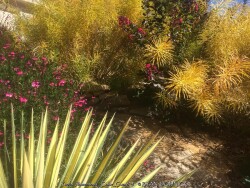

Adam's needle yucca (Yucca filamentosa) is a slow-growing broadleaf evergreen perennial. Blue-green leaves form rosettes about 2-3 feet tall and wide. Tall white flower spikes reliably appear on mature plants in May and June. If pollination is successful, attractive seed heads form later turning to black before cracking open. Although yuccas are more typical of western deserts and grasslands, this one is native to central and eastern United States. Tough as nails, yuccas are the ideal plant for a no-maintenance garden. Normally a plant has specific requirements for success but Adam's needle yucca has only one: it cannot tolerate growing in standing water or really wet soil. Plant in full sun to dry shade in any soil! In the landscape yuccas are often seen planted alone by a mailbox or neglected old landscape because they have outlived the original owners and the landscape service life. The root system of decades old plants may take up the underground volume of a large trash can. Yuccas look best when combined with other flowering plants providing texture and color. In mass plantings, yucca can create an interesting architectural look. Combined with ornamental grasses, yuccas can create stunning contrasts with winter grass colors of pink, orange and rust. Yucca flowers are pollinated exclusively by the yucca moth and deserve a place in native plant and pollinator gardens. This is a true 4-season "Once it's there, it's there forever" plant! Color Guard Yucca (Yucca filamentosa 'Color Guard') is a beautiful variegated variety with a bright yellow stripe down the middle of the leaf. The yellow color turns pinkish red with full winter sun and cold temperatures creating a stunning effect. Landscape designers often count on this variety for winter color!
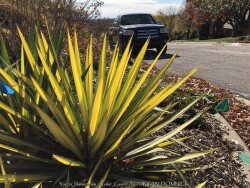

Adam's needle yucca (Yucca filamentosa) is a slow-growing broadleaf evergreen perennial. Blue-green leaves form rosettes about 2-3 feet tall and wide. Tall white flower spikes reliably appear on mature plants in May and June. If pollination is successful, attractive seed heads form later turning to black before cracking open. Although yuccas are more typical of western deserts and grasslands, this one is native to central and eastern United States. Tough as nails, yuccas are the ideal plant for a no-maintenance garden. Normally a plant has specific requirements for success but Adam's needle yucca has only one: it cannot tolerate growing in standing water or really wet soil. Plant in full sun to dry shade in any soil! In the landscape yuccas are often seen planted alone by a mailbox or neglected old landscape because they have outlived the original owners and the landscape service life. The root system of decades old plants may take up the underground volume of a large trash can. Yuccas look best when combined with other flowering plants providing texture and color. In mass plantings, yucca can create an interesting architectural look. Combined with ornamental grasses, yuccas can create stunning contrasts with winter grass colors of pink, orange and rust. Yucca flowers are pollinated exclusively by the yucca moth and deserve a place in native plant and pollinator gardens. This is a true 4-season "Once it's there, it's there forever" plant! Color Guard Yucca (Yucca filamentosa 'Color Guard') is a beautiful variegated variety with a bright yellow stripe down the middle of the leaf. The yellow color turns pinkish red with full winter sun and cold temperatures creating a stunning effect. Landscape designers often count on this variety for winter color!
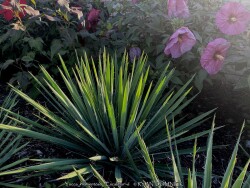

Adam's Needle Yucca (Yucca filamentosa) is a slow-growing broadleaf evergreen perennial. Blue-green leaves form rosettes about 2-3 feet tall and wide. Tall white flower spikes reliably appear on mature plants in May and June. If pollination is successful, attractive seed heads form later turning to black before cracking open. Although yuccas are more typical of western deserts and grasslands, this one is native to central and eastern United States. Tough as nails, yuccas are the ideal plant for a no-maintenance garden. Normally a plant has specific requirements for success but Adam's needle yucca has only one: it cannot tolerate growing in standing water or really wet soil. Plant in full sun to dry shade in any soil! In the landscape yuccas are often seen planted alone by a mailbox or neglected old landscape because they have outlived the original owners and the landscape service life. The root system of decades old plants may take up the underground volume of a large trash can. Yuccas look best when combined with other flowering plants providing texture and color. In mass plantings, yucca can create an interesting architectural look. Combined with ornamental grasses, yuccas can create stunning contrasts with winter grass colors of pink, orange and rust. Yucca flowers are pollinated exclusively by the yucca moth and deserve a place in native plant and pollinator gardens. This is a true 4-season "Once it's there, it's there forever" plant! 'Excalibur' is a beautiful compact bluish variety with lots of attractive curly white filaments on the edge of the leaves.


Pale green sword-like leaves from this yucca (Yucca glauca) make an excellent architectural statement with needle-like evergreen foliage. Over time, this yucca will form colonies of evergreen rosettes in its native habitat. Yucca glauca is the most cold-hardy yucca occuring in a large area of the North American great plains and short-grass prairies. The native habitat ranges from Texas to Canada and covers central Kansas predominantly in areas receiving 10-20" of rain per year. Having desert heritage, it resents poor drainage and winter moisture but will usually tolerate normal Eastern Kansas rainfall if planted in full sun on berm or south-facing wall with no extra irrigation. Use is primarily reserved for cactus or xeriscape gardens needing the fine needle-like texture of evergreen foliage and/or where Adam's needle yucca foliage might be too wide. Avoid placing near trees as fall clean-up of leaves can be a problem. Avoid use where children or pets play; needles are sharp and unforgiving! A large 2-3' wide specimen has flourished in our display garden in Lawrence, KS for over 15 years and flowered many times. Flowers are quite attractive and full of medicinal and edible uses for those inclined to learn more. Amazing that a yucca native to areas receiving as little as 10" of rain per year can grow in a climate receiving 40" of rain!
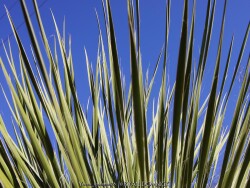

Bluish-green sword-like leaves from this yucca (Yucca rostrata) make an excellent architectural statement. Used as a patio plant in Kansas, place in full sun with no extra watering except from rainfall. Repotting may or may not be needed depending on how large you want the plant to grow. Potted plants are hardy to at least 0-5 degrees F if kept dry so you can wait awhile to move these in for the winter. Then move into a cold garage, basement, or bright window over the winter with NO watering. Luckily monocarpic flowering will never occur in a potted yucca so you don't have to worry about death after flowering. A suggestion to make this plant a lot more safe around your eyeballs is to clip the new spines off as the new leaves slowly unfurl. These spines are however softer and less dangerous than other yuccas. Although un-tested by the author, this yucca could survive in the ground in a microclimate under a south facing roof overhang kept completely dry in the winter and controlled water in the summer. It is suggested to buy a large plant to start with as growth is extremely slow, about 1-2" height per year. Many yuccas, including this one, may also be grown from rhizomes, stem cuttings, or by digging offsets from the side of established plants. Having desert heritage, it resents poor drainage and winter moisture. To counteract that in Kansas, plant in full sun on berm with poor sandy or rocky soil with no irrigation. A large 3-4' tall specimen has flourished in our display garden in Lawrence, KS (zone 6a). It is planted in limestone clay soil on a berm and has survived -16 degrees F and a week of single digit highs in February, 2021. ADDITIONAL INFORMATION ABOUT CREVICE GARDENING: In nature, some of the most interesting xeric plants grow in tough places such as inhospitable rock outcroppings with almost no soil. We can recreate that specific and exclusive growing environment with a crevice garden. Crevice gardening allows you to grow cold-hardy cacti and succulents that are normally cold hardy to our climate (Lawrence, KS zone 6a) but not normally tolerant of excessive moisture (40"/year), especially in the winter. This technique provides optimal xeriscape growing conditions by limiting the amount of soil and water around the roots and reducing the potential of root rot. Start with a raised mound of fast draining soil mix consisting mostly of decomposed granite, coarse sand, gravel, and a small amount of organic matter. Incorporate vertical rock formations such as flagstone into a raised landscape bed creating narrow 1-2" wide crevices filled with the soil mix. This helps quickly channel rain and snow melt water down more deeply into the soil encouraging deeper root growth while keeping the soil dry around the base of the plant. It is important that the entire mound is well above grade level to avoid drainage problems; crevice gardens typically range from 12"-36" tall. After installing the plants, mulch with a thin layer of pea-gravel or decomposed granite. In our Lawrence Kansas zone 6a winters with occasional polar vortexes or arctic blasts, this technique works well in any hot microclimate such as a south facing side of a berm or under a south or west facing roof overhand of a house or building. Kansas Plant Farm LLC built a trial crevice garden in 2022 and we have now had enough time to evaluate the plants after a true winter cold spell. During the arctic blast of January 2024, low nighttime temperatures got down to -11 degrees F (Jan 10th,2024). The longevity of this cold blast was also impressive: 4 days on a row with single digit highs including 1 day with a daytime negative high(-2F), 4 nights of lows in negatives (-8For lower), and 48 straight hours of 0 degrees F and mostly lower. A light snow cover helped insulate the ground but wind blew off most powdery snow on the foliage exposing the top parts of the plants to some extreme temperatures with surprisingly little damage. In our crevice trial gardens in Lawrence, KS (zone 6a), this variety survived so far.


Powder Blue sword-like leaves from this yucca (Yucca rostrata 'Sapphire Skies') make an excellent architectural statement. Used as a patio plant in Kansas, place in full sun with no extra watering except from rainfall. Repotting may or may not be needed depending on how large you want the plant to grow. Potted plants are hardy to at least 0-5 degrees F if kept dry so you can wait awhile to move these in for the winter. Then move into a cold garage, basement, or bright window over the winter with NO watering. Luckily monocarpic flowering will never occur in a potted yucca so you don't have to worry about death after flowering. A suggestion to make this plant a lot more safe around your eyeballs is to clip the new spines off as the new leaves slowly unfurl. These spines are however softer and less dangerous than other yuccas. Although un-tested by the author, this yucca could survive in the ground in a microclimate under a south facing roof overhang kept completely dry in the winter and controlled water in the summer. It is suggested to buy a large plant to start with as growth is extremely slow, about 1-2" height per year. Many yuccas, including this one, may also be grown from rhizomes, stem cuttings, or by digging offsets from the side of established plants. Having desert heritage, it resents poor drainage and winter moisture. To counteract that in Kansas, plant in full sun on berm with poor sandy or rocky soil with no irrigation. ADDITIONAL INFORMATION ABOUT CREVICE GARDENING: In nature, some of the most interesting xeric plants grow in tough places such as inhospitable rock outcroppings with almost no soil. We can recreate that specific and exclusive growing environment with a crevice garden. Crevice gardening allows you to grow cold-hardy cacti and succulents that are normally cold hardy to our climate (Lawrence, KS zone 6a) but not normally tolerant of excessive moisture (40"/year), especially in the winter. This technique provides optimal xeriscape growing conditions by limiting the amount of soil and water around the roots and reducing the potential of root rot. Start with a raised mound of fast draining soil mix consisting mostly of decomposed granite, coarse sand, gravel, and a small amount of organic matter. Incorporate vertical rock formations such as flagstone into a raised landscape bed creating narrow 1-2" wide crevices filled with the soil mix. This helps quickly channel rain and snow melt water down more deeply into the soil encouraging deeper root growth while keeping the soil dry around the base of the plant. It is important that the entire mound is well above grade level to avoid drainage problems; crevice gardens typically range from 12"-36" tall. After installing the plants, mulch with a thin layer of pea-gravel or decomposed granite. In our Lawrence Kansas zone 6a winters with occasional polar vortexes or arctic blasts, this technique works well in any hot microclimate such as a south facing side of a berm or under a south or west facing roof overhand of a house or building. Kansas Plant Farm LLC built a trial crevice garden in 2022 and we have now had enough time to evaluate the plants after a true winter cold spell. During the arctic blast of January 2024, low nighttime temperatures got down to -11 degrees F (Jan 10th,2024). The longevity of this cold blast was also impressive: 4 days on a row with single digit highs including 1 day with a daytime negative high(-2F), 4 nights of lows in negatives (-8For lower), and 48 straight hours of 0 degrees F and mostly lower. A light snow cover helped insulate the ground but wind blew off most powdery snow on the foliage exposing the top parts of the plants to some extreme temperatures with surprisingly little damage. In our crevice trial gardens in Lawrence, KS (zone 6a), this variety survived a harsh winter so far.
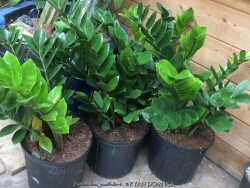

***Description for this plant available with future update!*** Zamioculcas zamiifolia is also known as ZZ Plant / Zanzibar Gem (Tropical).
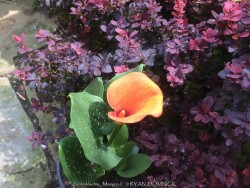

***Description for this hardy tropical available with future update!*** Zantedeschia 'Mango' is also known as Mango Hardy Orange Calla Lily >>>>>>>>>>>are typically grown for their mid-summer flowers and vertical iris-leaf foliage. The plants are temperate and subtropical herbaceous perennial bulbs native to areas with a summer wet season and dry winter. Gladiolus are hardy outside as a perennial when established and with minimal effort at least up to zone 6a. During the growing season, fertilize, water regularly, and plant in full sun. Plant these bulbs in the ground at least 6-8" deep with 3-4" of mulch to enjoy a wonderful tropical flowering effect! Foliage may look bedwraggled by fall so it is ok to cut back foliage at that time. They can also be grown as a flowering summer patio plant. If growing as a potted plant and trying to overwinter, allowing the foliage to frost is ok, it will not kill the root system. However, do not allow the pot with rootball to freeze solid or go below 20 degrees for more than a few hours; move into a cold garage or basement over the winter with no watering. Cut back and allow to go dormant and place entire pot back out in April or May with a time-release fertilizer. Another more labor intensive way to overwinter gladiolus is to remove them from the dirt, dust with fungicide, place in box with sawdust, and keep in the refrigerator. We consider this method old-fashioned and too much work but ok if you only want to save a few bulbs. If digging from the ground in colder zones, just save a big chunk with the dirt intact and place into a large pot in the garage. In a customer's garden in Lawrence, KS (zone 6a), four established specimens planted over 4-6" deep and mulched 2-3" with wood mulch survived -17 degrees F. During the arctic blast of February, 2021, lows down to -17 degrees F on Feb 16th, 2021 were recorded. The longevity of this cold blast was also impressive: 10 days on a row with highs of 10-15 degrees F or lower, 8 nights of lows in the single digits and negatives, and 36 straight hours of 0 degrees F and mostly lower.
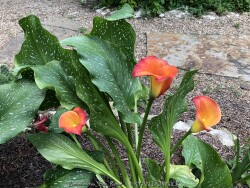

***Description for this hardy tropical available with future update!*** Zantedeschia 'San Remo' is also known as San Remo Hardy Red-Orange Calla Lily >>>>>>>>>>>are typically grown for their mid-summer flowers and vertical iris-leaf foliage. The plants are temperate and subtropical herbaceous perennial bulbs native to areas with a summer wet season and dry winter. Gladiolus are hardy outside as a perennial when established and with minimal effort at least up to zone 6a. During the growing season, fertilize, water regularly, and plant in full sun. Plant these bulbs in the ground at least 6-8" deep with 3-4" of mulch to enjoy a wonderful tropical flowering effect! Foliage may look bedwraggled by fall so it is ok to cut back foliage at that time. They can also be grown as a flowering summer patio plant. If growing as a potted plant and trying to overwinter, allowing the foliage to frost is ok, it will not kill the root system. However, do not allow the pot with rootball to freeze solid or go below 20 degrees for more than a few hours; move into a cold garage or basement over the winter with no watering. Cut back and allow to go dormant and place entire pot back out in April or May with a time-release fertilizer. Another more labor intensive way to overwinter gladiolus is to remove them from the dirt, dust with fungicide, place in box with sawdust, and keep in the refrigerator. We consider this method old-fashioned and too much work but ok if you only want to save a few bulbs. If digging from the ground in colder zones, just save a big chunk with the dirt intact and place into a large pot in the garage. In a customer's garden in Lawrence, KS (zone 6a), four established specimens planted over 4-6" deep and mulched 2-3" with wood mulch survived -17 degrees F. During the arctic blast of February, 2021, lows down to -17 degrees F on Feb 16th, 2021 were recorded. The longevity of this cold blast was also impressive: 10 days on a row with highs of 10-15 degrees F or lower, 8 nights of lows in the single digits and negatives, and 36 straight hours of 0 degrees F and mostly lower.
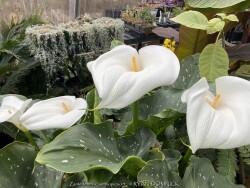

***Description for this hardy tropical available with future update!*** Zantedeschia aethiopica is also known as Hardy White Calla Lily >>>>>>>>>>>are typically grown for their mid-summer flowers and vertical iris-leaf foliage. The plants are temperate and subtropical herbaceous perennial bulbs native to areas with a summer wet season and dry winter. Gladiolus are hardy outside as a perennial when established and with minimal effort at least up to zone 6a. During the growing season, fertilize, water regularly, and plant in full sun. Plant these bulbs in the ground at least 6-8" deep with 3-4" of mulch to enjoy a wonderful tropical flowering effect! Foliage may look bedwraggled by fall so it is ok to cut back foliage at that time. They can also be grown as a flowering summer patio plant. If growing as a potted plant and trying to overwinter, allowing the foliage to frost is ok, it will not kill the root system. However, do not allow the pot with rootball to freeze solid or go below 20 degrees for more than a few hours; move into a cold garage or basement over the winter with no watering. Cut back and allow to go dormant and place entire pot back out in April or May with a time-release fertilizer. Another more labor intensive way to overwinter gladiolus is to remove them from the dirt, dust with fungicide, place in box with sawdust, and keep in the refrigerator. We consider this method old-fashioned and too much work but ok if you only want to save a few bulbs. If digging from the ground in colder zones, just save a big chunk with the dirt intact and place into a large pot in the garage. In a customer's garden in Lawrence, KS (zone 6a), four established specimens planted over 4-6" deep and mulched 2-3" with wood mulch survived -17 degrees F. During the arctic blast of February, 2021, lows down to -17 degrees F on Feb 16th, 2021 were recorded. The longevity of this cold blast was also impressive: 10 days on a row with highs of 10-15 degrees F or lower, 8 nights of lows in the single digits and negatives, and 36 straight hours of 0 degrees F and mostly lower.>>>>>This plant can also be used as a marginal aquatic plant growing in shallow water. It can also grow as a bog plant needing constantly moist soil rich in organic matter. As a rain garden plant, it will thrive is a depressed area in the landscape that collects rain water from a roof during spring and summer periods of rain but then go dormant if the water hole dries out completely.
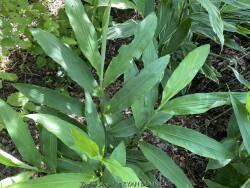

***Description for this hardy tropical available with future update!*** Zingiber mioga is also known as Japanese Woodland Ginger / Hardy Edible Ginger >>>>>>>>>>>In our trial gardens in Lawrence, KS (zone 6a), three established mulched specimens survived -17 degrees F. During the arctic blast of February, 2021, lows down to -17 degrees F on Feb 16th, 2021 were recorded. The longevity of this cold blast was also impressive: 10 days on a row with highs of 10-15 degrees F or lower, 8 nights of lows in the single digits and negatives, and 36 strait hours of 0 degrees F and mostly lower.


***Description for this hardy tropical available with future update!***White Feather Hardy Edible Ginger / Zingiber, is also known as Zingiber mioga 'White Feather'